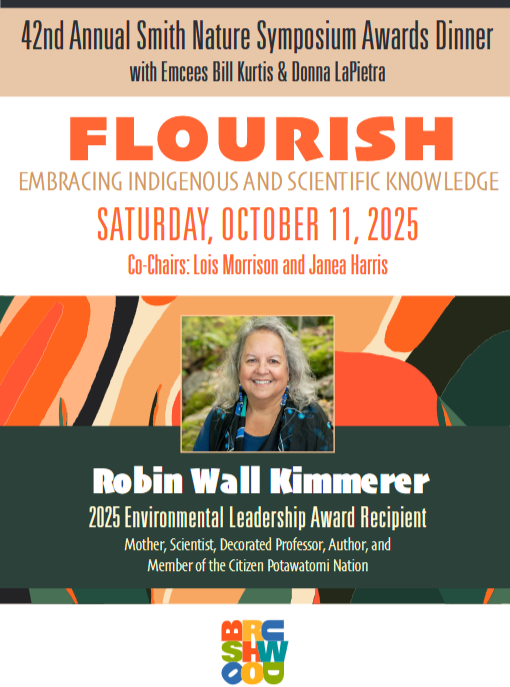42nd Annual Smith Nature Symposium Awards Dinner

Flourish: Embracing Indigenous and Scientific Knowledge
Support Brushwood's impact at the 42nd Annual Smith Nature Symposium
Honoring author, scientist, mother, professor, and member of the Citizen Potawatomi Nation, Robin Wall Kimmerer
Saturday, October 11, 2025
Chicago Botanic Garden
1000 Lake Cook Road, Glencoe, IL 60022
Smith Nature Symposium Co-Chairs:
Lois Morrison and Janea Harris
About the Smith Nature Symposium
2024 Environmental Leadership Award winner Dr. Mona Hanna with emcees Bill Kurtis and Donna La Pietra at the Smith Nature Symposium Awards Dinner
The Smith Nature Symposium is Brushwood’s largest fundraising event of the year, and all funds raised from the Smith Awards Dinner directly benefit our programs for youth, families, and Veterans across our community.
On May 6, 1984, more than 350 people gathered for the first Smith Nature Symposium featuring Roger Tory Peterson. Organized under the leadership of Barbi Donnelley, Symposium Co-Chair, this jam-packed convening of nature-lovers became the first of four decades of annual Symposia memorializing the significant civic legacy of Hermon Dunlap and Ellen Thorne Smith, who donated their land and cabin to help form Ryerson Woods.
About Robin Wall Kimmerer
Robin Wall Kimmerer is a mother, scientist, decorated professor, and enrolled member of the Citizen Potawatomi Nation. She is the author of The Serviceberry: Abundance and Reciprocity in the Natural World, Braiding Sweetgrass: Indigenous Wisdom, Scientific Knowledge and the Teachings of Plants and Gathering Moss: A Natural and Cultural History of Mosses. She lives in Syracuse, New York, where she is a SUNY Distinguished Teaching Professor of Environmental Biology, and the founder and director of the Center for Native Peoples and the Environment.
The Serviceberry
As Indigenous scientist and author Robin Wall Kimmerer harvests serviceberries alongside the birds, she considers the ethic of reciprocity that lies at the heart of the gift economy. How, she asks, can we learn from Indigenous wisdom and the plant world to reimagine what we value most?
Our economy is rooted in scarcity, competition, and the hoarding of resources, and we have surrendered our values to a system that actively harms what we love. Meanwhile, the serviceberry’s relationship with the natural world is an embodiment of reciprocity, interconnectedness, and gratitude. The tree distributes its wealth—its abundance of sweet, juicy berries—to meet the needs of its natural community. And this distribution insures its own survival.
As Kimmerer explains, “Serviceberries show us another model, one based upon reciprocity, where wealth comes from the quality of your relationships, not from the illusion of self-sufficiency.”
Braiding Sweetgrass
As a botanist, Robin Wall Kimmerer has been trained to ask questions of nature with the tools of science. As a member of the Citizen Potawatomi Nation, she embraces the notion that plants and animals are our oldest teachers. In Braiding Sweetgrass, Kimmerer brings these two lenses of knowledge together to take us on “a journey that is every bit as mythic as it is scientific, as sacred as it is historical, as clever as it is wise” (Elizabeth Gilbert).
Drawing on her life as an indigenous scientist, a mother, and a woman, Kimmerer shows how other living beings—asters and goldenrod, strawberries and squash, salamanders, algae, and sweetgrass—offer us gifts and lessons, even if we’ve forgotten how to hear their voices.
In a rich braid of reflections that range from the creation of Turtle Island to the forces that threaten its flourishing today, she circles toward a central argument: that the awakening of a wider ecological consciousness requires the acknowledgment and celebration of our reciprocal relationship with the rest of the living world. For only when we can hear the languages of other beings will we be capable of understanding the generosity of the earth, and learn to give our own gifts in return.



